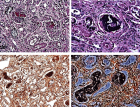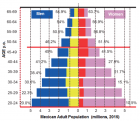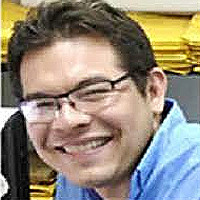Table of Contents
Comparison of Lung Function of normal and persons with chronic low back pain and its relation with duration and severity of Chronic Low Back Pain
Published on: 13th October, 2017
OCLC Number/Unique Identifier: 7286424899
Introduction: Chronic low back pain is one of the most prevalent musculoskeletal disorders. Studies have shown certain relations between physical fitness and chronic low back pain (CLBP) by examine some measures of physical fitness. The aim of study was to measure lung function using winspiro PRO in patient with CLBP versus normal healthy individual, and relation of lung function with duration and intensity of CLBP.
Methodology: The study population is comprised of a total of 120 adult persons. 60 subjects with chronic low back pain (41 male and 19 female) with a mean age of 30.69 years (+4.34) and 60 normal individual (39 male and 21 female) with mean age of 29.00 years (+5.34).
Results:The result of comparison of the respiratory parameter forced vital capacity (FVC), and maximal voluntary ventilation (MVV) of individual with CLBP show a significant difference as compare to the normal healthy population. In unrelated ‘t’ test the patient with CLBP (N=60) of age 30.51(SD±4.33), height 169cm (SD±1.23), weight 57.86(SD±7.73) and body mass index (BMI) 20.46 (SD±2.54) show a significant difference in respiratory parameter FVC ( t=17.244, P=0.000), and MVV ( t=11.048, P=0.000) as compare to the normal healthy persons (N=60) of age 29.79 (SD±5.28), height 170cm (SD±1.13), weight 59.40(SD±6.97) and BMI 21.59 (SD±3.29).In patient group- FVC range is 34.0% to 75.00% (52.85%±9.30). MVV range is 45.0% to 86.80%. (63.11%±12.06)In control group FVC range is 63.90% to 98.83% (83.63%±7.59). MVV range is 63.00% to 98.00% (78.96%±7.86).
Conclusions:The overall result of the study show that there is a significant difference in the respiratory parameter that is FVC (forced vital capacity), and the MVV (maximum voluntary ventilation) in persons with chronic low back pain as compare to the healthy person of same age, height, weight and body mass index (BMI).
Determining the use and value of social support in Telerehabiliation Interventions for individuals with Multiple Sclerosis: A narrative synthesis review
Published on: 3rd October, 2017
OCLC Number/Unique Identifier: 7286430437
Background: Telerehabilitation has been identified as an effective treatment that promotes exercise rehabilitation in individuals with multiple sclerosis (MS). Social support is recognised as a core element of such interventions. However further research is needed to consider the role and value of different social support domains.
Aim: Review available literature to assess and synthesise the use and value of social support within telerehabilitation interventions for individuals with MS.
Method: A narrative synthesis was conducted. A systematic search of included articles was conducted. Electronic databases were searched from inception to January 2017. Other search methods were undertaken. Evaluation and synthesis of included articles utilised risk of bias assessment and a 4-stage synthesis process.
Main Results: A total of fourteen studies, involving 718 participants (505 female, 213 male; aggregated mean age 47.6 years) with MS, were included. Esteem support was the most frequently reported method of social support, followed by informational, emotional and tangible. It would appear social support can be beneficial in assisting participants to adhere to treatment interventions. Visual feedback may be directly beneficial to improve impaired balance in individuals with MS. A model for future interventions is provided.
Conclusions: Social support appears to increase the adherence of participants with MS to telerehabilitation interventions. Unique findings provide an indication for the direction and content of future interventions. Further research is necessary to ascertain the optimal types and frequencies of social support delivery and its effect on health outcomes for participants with MS.
Rehabilitation of proximal humerus fractures: An environmental scan of Canadian physiotherapy practice patterns
Published on: 20th September, 2017
OCLC Number/Unique Identifier: 7286350490
Background: Proximal humerus fractures (PHFs) are common injuries particularly in older adults. Evidence-based protocols for PHF rehabilitation are lacking and physiotherapists use a variety of interventions.
Purpose: To determine practice patterns and perceptions of physiotherapists who treat adults with PHF in Ontario, Canada.
Method: A paper and pencil survey asking about respondent demographics and management of Neer Group 1 (minimally/nondisplaced) and complex (displaced 3- and 4-part) PHF was mailed to 875 randomly selected physiotherapists who were registered with the College of Physiotherapists of Ontario in 2013/2014 and working in practice areas likely to be accessed by adults with PHF.
Results: The response rate was low (10%); 83 physiotherapists completed the survey - 80% had experience managing PHF. Respondents treated 1-5 individuals with PHF annually; more treated Neer Group 1 PHF (89%) than complex PHF (68%). Most individuals with PHF were older than 60 years (64%), female (76%) and accessed physiotherapy through a doctor’s referral (91%) more than 1 month post injury (33%).
Main findings: Physiotherapists manage PHF using multi-component interventions and a minimum of 76% include the following elements: education and progression of passive, active assisted, active range of motion exercises and muscle retraining to build coordination and strength. Use of other elements was variable. The main factors influencing the treatment plan were the ability of the individual with PHF to comply, bone quality, and fracture type. Most respondents were unsure that there is sufficient PHF rehabilitation literature to guide treatment.
Conclusions:This environmental scan is the first North American study to document practice patterns and attitudes of physiotherapists providing PHF rehabilitation. Elements used by physiotherapists in Ontario treating small numbers of individuals with Neer Group 1 or complex PHFs each year align well with the limited PHF rehabilitation literature available.
Potential implications:Multi-disciplinary collaborations to design and conduct large, high quality, multi-centre prognostic studies and RCTs that evaluate the effectiveness of key aspects of non-surgical PHF rehabilitation in various patient groups are needed. Meanwhile, consensus guidelines should be developed in the context of region-specific physiotherapy service models to inform best practice in PHF rehabilitation management.
Frequency specific microcurrent resolves chronic pain and adhesions after ulnar transposition surgery
Published on: 19th September, 2017
OCLC Number/Unique Identifier: 7286350677
Frequency specific microcurrent (FSM) has been used to treat myofascial pain syndrome [1,2] fibromyalgia associated with spine trauma [3], delayed onset muscle soreness [4], acute and chronic neuropathic pain [5] and chronic scarring in burn patients [6]. In this case, its use was modified to include not only the treatment of neuropathic pain but the treatment of neural adhesions in a patient with a ten year history of pain at rest and painful restricted range of motion following an ulnar nerve anterior transposition surgery in 2001. Eleven standard physical therapy sessions including augmented soft tissue mobilization using plastic tools, and muscle strengthening exercises and stretching failed to resolve symptoms. Three sessions of frequency specific microcurrent produced complete resolution of pain and symptoms. Patient remained symptoms free at one-year follow up.
The efficacy of complex Decongestive Physiotherapy in patients with Bilateral Primary Lower Extremity Lymphedema and Untreatable multiple health conditions: A Case Report
Published on: 8th September, 2017
OCLC Number/Unique Identifier: 7286355299
Background: Primary lymphedema occurs as a result of genetic abnormalities of the lymph system. Currently, complex decongestive therapy is accepted as the standard treatment of the lymphedema. In this case presentation, we described the management of bilateral primary lower extremity lymphedema and the use of complex decongestive therapy.
Case Report: A 62 years old female patient had stage III primary lymphedema on her left lower extremity and stage II primary lymphedema on her right lower extremity. The patient, who had morbid obesity, also had untreatable sleep apnea, urinary incontinence, umbilical hernia and hypertension controlled by drugs. She had stage 4 gonarthrosis according to Kellgren – Lawrence classification in her both knees. The patient received complex decongestive therapy as an outpatient.
After 27 sessions of complex decongestive therapy, edema reduced in both lower extremities. Before the treatment started, the patient couldn’t go up and down stairs, get out and had difficulty mobility in the home. But after the treatment, the patient could go up and down 16 stairs by holding the railing, get out by two walking sticks and had less difficulty mobility in the home. However, due to gonarthrosis in her knees, her pain did not diminish.
Conclusion: Complex decongestive therapy is effective in the management of bilateral primary lower extremity lymphedema, which progressed with multiple health conditions.

HSPI: We're glad you're here. Please click "create a new Query" if you are a new visitor to our website and need further information from us.
If you are already a member of our network and need to keep track of any developments regarding a question you have already submitted, click "take me to my Query."



















































































































































